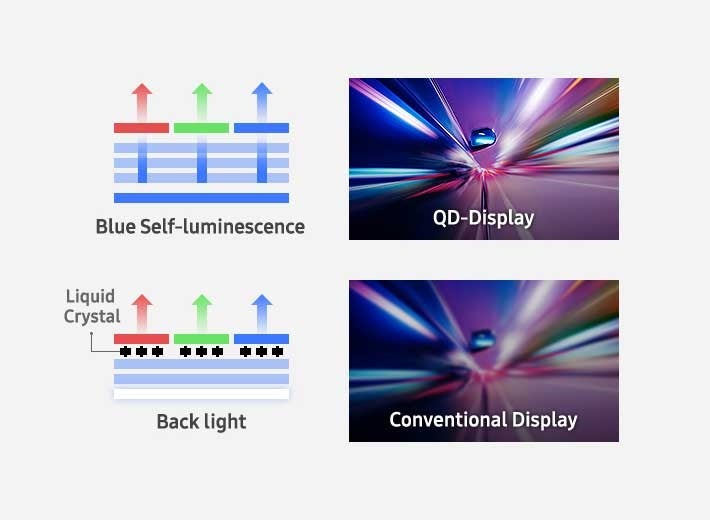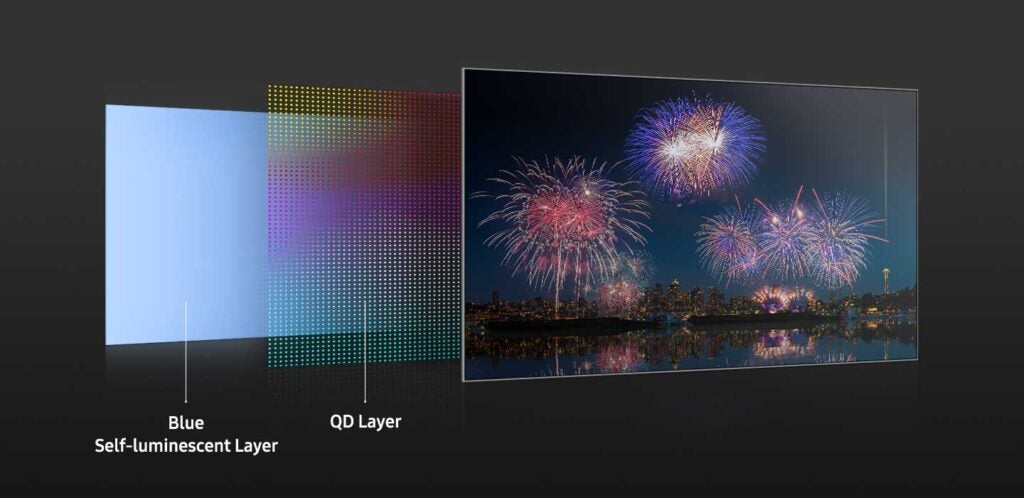Samsung’s QD-OLED display entered the TV market as a challenger to LG Display’s WOLED panels, and in a short space of time it’s established itself as one of the best TVs and gaming monitors in the world.
After dismissing OLED technology for well over a decade, Samsung re-entered the market and created panels of its own to fix the issues it had with OLED – namely a lack of brightness and a reduced colour performance.
It’s arguably done that and more by merging Quantum Dot colour technology with OLED’s pixel level dimming ability, spurring LG Display’s WOLED panels to even greater levels of performance.
With this guide we explain what QD OLED is, how it works, where you can find it, and ultimately whether it’s worth getting a QD OLED display.
What are Quantum Dot TVs?


Quantum Dot displays are more advanced versions of LCD LED TVs. They make use of nano-sized particles that absorb and emit light. When light is passed through these particles, different sizes produce different wavelengths (i.e. colours).
Quantum Dots are known for their purity which means they can display colours more accurately, and their light efficiency also allows for greater brightness, which is useful for dealing with HDR content.
What’s more Quantum Dots are very stable. That means the stability of image quality is maintained over a longer period than, say, WOLED (White OLED) TVs, which degrade over time.
What are OLED TVs?


OLED stands for Organic Light Emitting Diode. Each pixel is self-emissive, which means it can produce its own light and colour. This produces high levels of contrast as a pixel that’s ‘on’ can sit next to a pixel that is ‘off’.
This allows for deep black levels, something that’s tricky for LCD TVs to achieve as they employ a backlight panel where light can leak through the screen.
Although OLED TVs are making gains in terms of brightness every year, LCD TVs with Quantum dots can go brighter, which allows for a wider range of colours to be shown. There is also the potential for image retention and burn-in. though that’s increasingly less of an issue for OLED TVs.
What is a QD-OLED TV?


Like WOLED, a Quantum Dot OLED is an emissive display with pixels that can emit its own light and colour without the need for a backlight, producing deep black levels, high contrast and wide viewing angles.
A QD OLED uses a QD Layer – the Quantum Dot filter – which functions like it does in a QLED TV in producing more accurate and wider range of colours. It retains colour saturation (the intensity of the colour) at wider angles better than OLED, as QD-OLED can emit light from its screen in all directions.
When QD OLED first launched, Samsung Display’s original aim was to achieve 1000 nits of brightness with the QD-OLED screen, with a high contrast ratio (1,000,000:1) to help create ‘perfect blacks’ for a more detailed and convincing image.
With the fourth gen version of the panel, it’s claimed QD OLED can reach up to 4000 nits in certain circumstances.
How does QD-OLED work?
A TV display creates three different colours of light: red, green, and blue. How these colours are combined creates the image seen on screen.
A QLED TV shines blue light into a Quantum Dot filter to create red and green light. When the blue light source is combined with the red and green light, it creates a white light made up of saturated red, green and blue to cast an image on screen.


OLED screens produced by LG Display use blue and yellow OLED materials to produce a white light (hence why they’re also referred to as WOLED or White OLED). That light is passed through a colour filter to create the red, green and blue pixels that form the image on screen.
A QD-OLED uses a blue self-luminescent layer to beam blue light into the quantum dot filter. The filter takes some of the blue light and converts it into red and green, and the combination of this red, green and blue light creates the resulting image.


Why does a QD OLED display use blue light for this process? Blue light has the strongest ‘light energy’ and so can achieve a “relatively bright luminance”. As the panel does not create a white light like a WOLED does, it offers a purer RGB image and it’s able to maintain colour saturation (depth of colours) even at high brightness levels.
Is QD -OLED better than OLED?
In a straight fight between the two displays, QD OLED is considered to be better than OLED in its reproduction of colours.
As QD-OLED uses a Quantum Dot RGB filter, it creates purer red, green and blue colours than OLED, which are diluted by having a white light merge with its RGB colours.
With purer colours, QD-OLED hits a wider colour gamut (i.e. the range of colours it can show), so technically it offers better colour saturation, and a wider, more precise range of colours than OLED.
Brightness is similar between QD OLED and conventional OLED. The 4th gen QD OLED panel can hit 4000 nits on a 3% HDR window, which is the same as LG Display’s Primary RGB Tandem OLED. Viewing angles are slightly in the favour of QD-OLED but in other areas: contrast, black levels, motion – the two displays are pretty even.
Are there QD OLED gaming monitors?


It’s not just TVs that have adopted QD OLED panels. You can find them in gaming monitors too.
Because of its ability to control each individual pixel in a display, OLED has an advantage over LCD TVs by having a faster refresh rate (how many times per second the display updates the image).
With either an OLED or QD OLED model, you can get rapid input lag but add in QD OLED’s purer colour performance over WOLED and they can display a wider range of colours.
Sizes, however, only go as big as 49-inches (the smallest is 27-inches). Samsung, naturally, produces QD-OLED gaming monitors, but so does AOC, Asus and MSI.
Does QD-OLED suffer from burn-in?
All OLED panels can suffer from burn-in, though it’s not inevitable that you will experience it with an OLED TV.
That said, QD OLED TVs can suffer from image retention in much the same way as WOLED displays, and at the moment it would appear that WOLED mitigates burn-in better than QD OLED on some panels thanks to heat-sink integration that dissipates heat from the TV quicker.
The same advice applies to any OLED panel, which is to watch TV responsibly and not leave it on for days (especially on sources with static images, such as gaming icons). There is technology in OLED TVs that reduces image retention, and it gets better every year, which means that most people won’t even experience it.
Should you buy a QD-OLED TV?
Like OLED, QD-OLED is a premium TV display, which means it costs a fair bit. You’re unlikely to find a QD-OLED TV for less than £1000, even in a sale.
And part of the reason why is because QD-OLED TVs only come in three sizes – 55-, 65- and 77-inches. Samsung cannot currently make TV screens in any other sizes due to the production process. Sony’s Bravia 8 II is only available in 55- and 65-inch sizes.
What makes things slightly difficult in making a choice is that Samsung also uses LG Display’s OLED panels as part of its TV line-up. The Samsung 48-inch S90D is not a QD OLED TV but a WOLED panel.
Samsung also employs what’s called a “panel lottery” for its entry level OLED range, so you could buy the 2025 S90F TV, and you could get either an OLED or QD-OLED for some of its sizes. You can tell the difference by looking at the model number – a QD-OLED has a ‘T’ as the suffix of the model number.
Nevertheless, buying a QD-OLED offers a more colourful performance than a WOLED panel, along with all the advantages that OLED offers. If that appeals then a QD OLED panel is certainly worth buying, but picture is also just one part of what makes a good TV.




